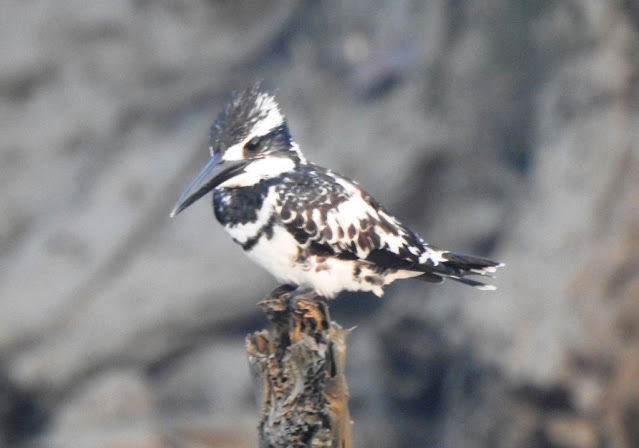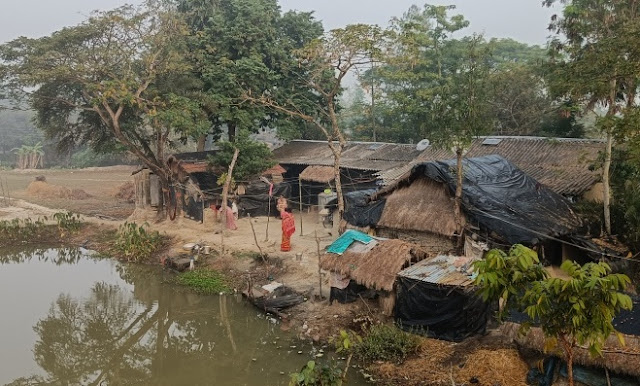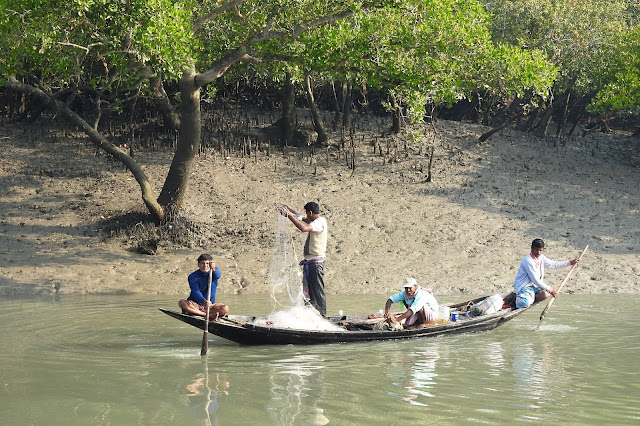If you thought that trying to watch birds from a moving motorboat in a mangrove
would be quite a challenge, you won't be too wrong. Notwithstanding that, the concept of spending
the entire day on a boat from sunrise to sunset, with an endless and
delectable culinary procession, briefly punctuated by the occasional bird
sighting, certainly qualifies as the most decadent birding experience!!
 | |||||
| Sunrise on the Bidyadhari river, Sunderbans, West Bengal, India |
This is exactly what was on offer for our trip to the Indian part of Sunderbans National park and tiger reserve, about 100 Km south of Kolkata
After meeting up with the group at the NSCBI Airport Kolkata, which, in my experience is the best AAI airport, we boarded our tempo traveler.
A stop at the nearby Barui wetland was planned due to a recent sighting of the Mute swan, a European bird but a vagrant in India.
The wetland seemed to be in it's last throes and had been squeezed from all sides by 'development'.
Here in the middle of nowhere, there was a DRDO setup and the gleaming new TV institute. A large plot had been walled off for the upcoming center for cultivation of science!
I wondered if these kids flying kites, and unknowingly
utilizing the laws of Newtonian physics, would one day walk these corridors.
While the mute swan had decided to stay away, a few hundred lesser whistling ducks still called the remaining water body as home.
The rest of the journey over terrible village roads took nearly four hours,
which seemed an eternity. Notable on this route was the complete absence of any
half decent dhaba /hotel. Thank God for the mandate by the petroleum ministry
compelling petrol pumps to have toilets….
 |
| The MB Shardul |
We were famished by the time we reached the Gadkhali jetty boarding point and immediately set sail in our boat called Shardul, which was waiting to serve piping hot Bengali delicacies. There was still enough light to get some splendid views of the specialty mangrove kingfishers before we disembarked at our camp.
 |
| The camp jetty on Datta river, Bijoynagar |
The camp had been built on a narrow strip of
farmland 4 years ago. It is a row of six rooms which were clean and spacious with sufficient
light points and piping hot water. Special effort had been made to plant
ornamental and flowering shrubs all around. The caretaker was a
perpetually happy looking helpful man who thought he could speak Hindi! He effusively shared his experience of 2 years of lockdown
wherein there was no Corona in the village but neither were there any tourists. He was pleased to spend his entire time gardening and working in the field.
He proudly showed off his paddy field that would
yield about a ton of rice from half an acre of plantation.
We would board our boat at sunrise and return only by sunset. The motorboat was
spacious enough for our group of 10 and had a neat loo. The propulsion and
controls were nothing short of amazing in their simplicity.
 |
| "Fly by wire" idea was adopted by Airbus after seeing this! |
Needless to say, the feasting often took precedence over the birding, thanks to the never ending food trail and the dazzling variety of seafood on offer. Hats off to the staff who live on the boat are able to manage all of this...and always with a smile.
 |
| Fishing for my lost cap! |
Their seamanship skills were equally impressive whether it was at the time of docking or when positioning the boat depending on the direction of the light and placement for bird sighting. Their years of experience was on ample display when my cap caught a gust and decided to fly off my bald pate. Before i could even realize what had happened, the boat was turning around and a long pole with a fishing net had appeared. Within a few minutes the itinerant cap had been sighted and expertly fished out.
One got a lesson in basic biology seeing the strange and pointed spears that stick out from the ground and surround the trees in the mangrove. It seems that all trees breathe from the roots, not leaves!! |
| Pneumatophores from roots of Mangrove trees |
A mangrove is a specialized ecosystem around brackish seawater where the 50 odd species of trees had acquired special adaptations to survive the peculiar environment of salinity, inundation and tidal movements. Since the roots are continuously submerged, the pneumatophores which sprout from the roots, work like snorkels and help the tree to breathe and live! The other adaptation is the ability to filter out excessive salt. The word Sunderban comes from the predominant mangrove tree species called Sundari tree.
The bird world also accordingly has specialized mangrove species which were on ample and regular display. These were the brown winged, black capped and collared kingfishers.
 |
| Brown winged kingfisher |
 |
| Black capped kingfisher |
 |
| Collared kingfisher |
The white throated,pied and common kingfisher were also regularly seen. The few
other species which can thrive in this environment included the lesser
whistling duck, whimbrel, Eurasian curlew, redshanks, sandpipers, bronze
drongo, ashy woodswallows and whiskered terns.
 |
| White throated kingfisher |
 |
| Common kingfisher |
 |
| Pied kingfisher |
 |
| Bronze drongo |
 |
| Ashy woodswallow |
 |
| Shikra |
 |
| Eurasian curlew |
 |
| Lesser adjutant srork |
 |
| Asian pied starling |
 |
| Grey heron |
The long gaps in bird sightings were made interesting by pearls of bird trivia like starlings have bicoloured beaks while mynas don’t; The only species of drongo seen in urban areas is the black drongo. All others like bronze, ashy, spangled and raquet tailed are found in jungles; Cranes have short beaks while storks have long beaks; Col Sykes gave scientific names for birds that he discovered after Indian gods like Galerida deva for Sykes Lark and Athene brahma for spotted owlet.
The boat was rather comfortable and one could keep looking at the water and mangrove forest endlessly while looking forward to the endless food orgy.
 |
| The Royal bengal birding experience |
 |
| Gulabjamun sunderbanii, a mangrove species! |
The sightings of Otters caused much excitement as
our guide followed the trail of footmarks, though he would have preferred to
chance upon the extremely rare but always possible sighting of the royal Bengal
tiger.
 |
| Oriental small- clawed otter |
Equally exciting was the sight of the very large monitor lizards which seemed right out of Jurassic park. The mother of all Jurassic creatures were these huge crocodiles which were basking and not too pleased by our intrusion.
 |
| Water Monitor Lizard..one of the largest in the world!! |
 |
| Sajnekhali Camp |
While motorized boats are very convenient, especially for tourists, the good
old row boat is what most fishermen preferred, there being little investment and no fuel costs. The price of sweat being the most underrated….
The hybrid sailboat - oarboat rigged from crude polythene sheets was yet another
example of the Great Indian jugaad.
This fishing family didn’t seem to mind putting the
woman of the house in pole position

The morning walk around the resort along the dyke overlooking the village
turned out to be the best birding hour. The black headed cuckoo shrike,
emerald dove, grey headed starling, black naped monarch flycatcher, blue
throated barbet were notable among other backyard species spotted.
 |
| The dyke which protects the village from the hungry tides |
What was also on display was the perfect example of life in a village which was protected from the wrath of the hungry tides by a dyke. There were bamboo/mud houses with tiled roofs. The pond was the source of fish and water. The rice field behind was lush. The borewell and pump produced sweet water. The goats and cows had their own individual dwellings. There was a solar panel on the roof and even a DTH dish!!
 |
| The idyllic village house |
As we were packing and leaving for the boat, it was with utter amazement that we witnessed this unusual relationship between the resident straydog and the tabby at the resort. Everyone knows that cats are dogs are natural enemies. Here the tabby seemed to not only enjoy the company but was actively rubbing himself against the dog. If only differently born people, supposed to be natural enemies, might someday find it within themselves to go against their Nature and forge such friendships...
 |
| Unnatural relationship? |
The last morning was slightly overcast, as predicted, but as soon as we set
sail, we had a spectacular sighting of the jungle cat that was basking on the
forest edge. The display of the whiskered terns occupying their individual
bamboo poles brought up the end of our boatride just as the breeze picked up.
 |
| Jungle cat |
 |
| Whiskered tern |
A drizzle started just as we got into our vehicle and soon turned into a sharp shower even as we headed back to the airport.
The food orgy continued at another pitstop on the way to the airport. The eco
park in Kolkata Newtown, boasts of a leisure area with a food court having
outlets of all the famous sweetmaker brands of Kolkata. It was just not humanly
possible to resist gorging on the variety of shondesh and chenna sweets from
all possible names like KC Das, Bancharam etc.
 |
| Taj Mahal@Ecopark, New Town, Kolkata! |
 |
 |
| The Group |
Tour dates: 17-20 Feb 2022
Camera: Nikon P 900
Tour operator: Nature India
Stay: Sunderban JD Camp
Local Guide and Boat: Mr Nityananda Chowkidar
Recommended pre-visit reading : The Hungry tides by Amitava Ghosh
 |
| Kolkata Airport. Just in case.. |



















